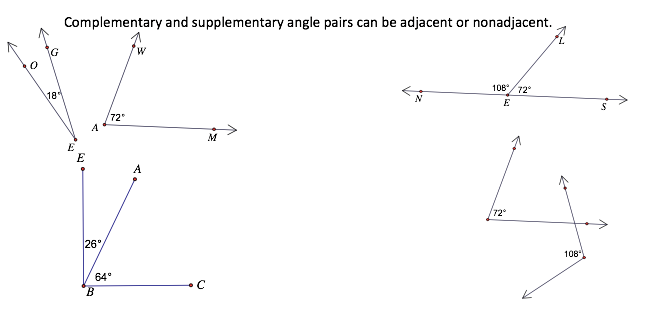
Geometry Notes Section 1.5: Angle Relationships
[size=200][color=#00ff00]Please try #1 while you wait for class to begin. :)[/color][/size]
#1)[br]a) Move and review the point, segment, ray, line, and angle. [br]b) Change the colors using the black square that appears when you select the item.[br]c) Draw a new point [icon]/images/ggb/toolbar/mode_complexnumber.png[/icon] , segment [icon]/images/ggb/toolbar/mode_segment.png[/icon] , ray [icon]/images/ggb/toolbar/mode_ray.png[/icon] , line [icon]/images/ggb/toolbar/mode_join.png[/icon] , and angle [icon]/images/ggb/toolbar/mode_angle.png[/icon] .
[size=200][color=#ff0000]Wait for the class, please. :)[/color][/size]
[size=200][color=#0000ff][size=150] Two angles are [b]COMPLEMENTARY[/b] if the sum their measures is 90˚and [b]SUPPLEMENTARY[/b]if the sum is 180˚. [/size][/color][/size]
#2)[br]1. Complementary, supplementary, or neither?[br]a) 70˚ and 110˚[br]b) 23˚ and 57˚[br]c) 17˚ and 73˚
[size=150][color=#00ff00]Try #3 on your own:[/color][/size]
#3) Find the COMPLEMENT and the SUPPLEMENT for:[br]a) 20˚
b) x˚
c) (90-m)˚
d) (180-t)˚
[size=200][color=#0000ff][b]Adjacent angles [/b]are two angles that share a common vertex and a common side, but have no common interior points.[/color][/size]
[size=200][color=#ff0000]Do #4 and #5 on your [/color][color=#9900ff]PRINTED NOTES[/color][color=#ff7700].[/color][/size]
[size=150][color=#0000ff]Complementary and supplementary angle pairs can be adjacent or nonadjacent.[/color][/size]

[size=200][color=#ff0000]Do #6 and #7 on your[/color] [color=#9900ff]PRINTED NOTES[/color][color=#ff7700].[br][/color][/size][size=200][size=150]We will do # 8 on your[/size][/size] PRINTED NOTES [size=150]together.[/size]
[size=200]#9 below, and then on [color=#9900ff]PRINTED NOTES[/color][/size]
Click the check boxes one by one.
[size=200]#10 together on [color=#9900ff]PRINTED NOTES[/color][color=#ff7700].[/color][/size]